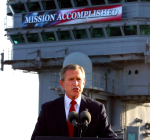Letter from Europe: Bomb Scare
***
BERLIN—As a child of the Nuclear Age, I arrive replete with memories of crawling under our wooden school desks during futile A-Bomb fire drills, and flipping through the pages of Popular Mechanics magazine to gaze at do-it-yourself blueprints for equally futile A-Bomb shelters. I was “just a gleam” in my father’s eye—that’s a phrase he liked to use while recounting the legend of my impending birth in Chicago—when the scientists in a lab under Alonzo Stagg Field at the University of Chicago demonstrated that splitting the atom could produce an unprecedented military threat, and just a toddler during World War II when my Uncle Harold, a UC biologist, went off to do some mysterious work for the Manhattan Project that produced the first atomic weapons.
So I was easily persuaded by the recent alarms raised by the media and the Bush administration’s propaganda department about the threat of nuclear weapon development in Iran and North Korea, thus violating the already shaky 1968 nuclear Non-Proliferation Treaty. What I didn’t realize until I read Jason Epstein’s “Hurry Up Please, It’s Time” (The New York Review of Books, March 15, 2007), is that the major violators of the Non-Proliferation Treaty are not fundamentalist Iran or wonky North Korea, but the major bomb-possessing powers, the United States, Russia, Britain, France and China (plus the recent aquirees of nuclear weapons, India, Pakistan, and Israel). Until Epstein’s review of a genuinely scary new book by the Carnegie Endowment’s director of non-proliferation, Joseph Cirincione’s Bomb Scare: The History and Future of Nuclear Weapons (Columbia, 2007), I’d forgotten all about Article 6. It’s easy to forget.
Article 6 of the treaty (it’s available online, and now signed by 188 countries) commits the nuclear weapons possessing powers to dispose of their bombs, to “general and complete nuclear disarmament.” As former US Defense Secretary Robert McNamara, cited approvingly by Cirincione, puts it, the continued possession of large nuclear arsenals by the US and its NATO allies is “insane… immoral, militarily unnecessary and destructive of the non-proliferation regime.” Epstein explains that “Mr. McNamara was referring to the failure of the original nuclear states to abide at this late date by their commitment under the Non-Proliferation Treaty negotiated in 1968 to agree to dispose of their nuclear weapons.” Nearly four decades later, the nuclear powers still possess some 27,000 bombs, "each bomb capable of destroying a city, and generating a vast cloud of nuclear poison."
“It is difficult, if not impossible,” Cirincione writes, “to convince other states to give up their nuclear ambitions or to adhere to nonproliferation norms when immensely powerful nuclear weapons states reassert the importance of these weapons to their own security.” Thus, there “is a real possibility… of a system-wide collapse of the nuclear nonproliferation regime. If it were to occur it could bring the world back to the brink of annihilation for the first time in some twenty years,” he says. While the transitory focus of our general Attention Deficit Disorder may be on the latest UN Security Council sanctions aimed at discouraging Iranian weapon-making nuclear ambitions (the Security Council vote on March 24 was unanimous, by the way), the ongoing non-proliferation violation by the US and others is not on our screens.
Although I’m of course interested in the big question raised by books like Cirincione’s, namely, Will we—can we—respond?, what caught my eye in the chill of reading Epstein’s piece is his historical reflection on the issue. He’s worth quoting:
“Today’s impending nuclear arms race echoes the frenzied militarization of a century ago when the European powers still had time to avert the senseless catastrophe that would soon befall their people, a catastrophe whose unforeseen consequences include, among others, the Bolshevik Revolution, Hitler, World War II, nuclear weaponry, the Holocaust, the cold war, and the unstable entity known as Iraq. Urgent disarmament proposals dismissed then as naïve, impractical, and so on must be seen in light of the madness that followed to have been the greatest wisdom. It was the sleepwalking war makers who proved to be naïve and impractical as they led their countrymen into the abyss from which emerged the disasters of the twentieth century and beyond. The difference between then and now is that there may be no one left to render a similar retrospective judgment should the nuclear powers fail to disarm.” Read that last sentence of Epstein’s one more time.
“Without compliance under the Non-Proliferation Treaty the world faces a multilateral nuclear environment whose inherent instability will be greater by orders of magnitude than the fragile cold war truce whose near violation during the Cuban Missile Crisis was much on the minds of Reagan and Gorbachev when they hoped but failed to eliminate their suicidal weaponry twenty years ago at Reykjavik, joking bravely about throwing a party for the world when the last weapon was junked. Instead the world awaits what those leaders dreaded, a spark—the kidnapping of a girl named Helen, the murder of a trivial archduke in a minor country, the fantasies of ideologues, fools and fanatics, of which recent history provides so many examples—to bring the history of our armed and dangerous warrior species to an end.”
Ironically, as I contemplate Epstein’s grim vision of our prospects, it’s a bucolic spring morning in Berlin where a party is indeed being thrown, if not for the world, at least for the continent which is marking the 50th anniversary of the founding of the European Union, and concomitantly a half-century in which the countries of Europe have been at peace with each other. The celebrations may be a bit bland—the press calls it “The Boring Miracle”—but that’s precisely the point: a half-billion Europeans can more or less take for granted general peace, borderless travel within the EU, a common and pretty stable currency, and the right to live and work anywhere in the now 27-country federation.
But behind the strolling crowds in the heart of Berlin, spectres still haunt Europe, if not the spectre of communism that Karl Marx once championed. Says Epstein: “Rather than dread these suicidal weapons, nations embrace them as symbols of strength, imagining future conflicts in which their enemies but not themselves are vaporized, a flight from reality that would be shocking were it not so deeply embedded in human behavior as to seem normal when we consider the excited crowds in the squares and boulevards of August 1914 cheering their imminent slaughter.” One of the gates those youthful troops marched through, expecting to be victoriously home by Christmas 1914, was Berlin's Brandenburg Gate itself, the site of today’s 50th anniversary festival of European peace.
Let’s “assume the worst and most likely outcome,” Epstein suggests: “negotiations and threats fail and Shiite Iran a decade or less hence, like North Korea today, tests a bomb with impunity provoking its Sunni neighbours—Saudi Arabia and Egypt—to arm themselves accordingly. Or the Musharraf government fails and jihadis come into possession of Pakistan’s nuclear arsenal… Or perhaps Israel attacks Iran’s nuclear sites, precipitating a Middle East arms race fueled by a nuclear industry revived by the rising cost of fossil energy.” Nor is Europe exempt from the nuclear spectre. According to Epstein, "the US has already placed between 180 and 480 tactical warheads in Belgium, Holland, Germany, Italy and Turkey in further violation of the Non-Proliferation Treaty, inviting Iran and other future nuclear states to do the same for their allies." Just imagining a worst-case scenario is more than enough.
As Epstein admits, when contemplating the objections to proposals that the nuclear powers abide by the Non-Proliferation Treaty, “It will surely be objected to on practical grounds that nothing—neither the prospect of unbridled proliferation nor the wisdom of Chekhov’s assurance that a gun over the mantle in Act One foreshadows a shooting by Act Three—will convince today’s nuclear powers to junk their weapons of mass suicide, not even the increasing certainty that multilateral nuclear deterrence is impossible.”
Unlike the fantasised WMDs of Iraq, in this case we know exactly where the WMDs are located. But, as Epstein laments, “The perennial popularity of the Book of Revelations suggests the depth to which our careworn and deadly species is intrigued by fantasies of escape: by apocalypse, Armageddon, Goetterdaemmerung, nirvana, and other nihilist heavens.” He adds, as “unlikely as nuclear disarmament may be, it is worse than foolish not to urge it.” Urging may be the best we can do. But the alternative is that “there may be no one left to render a… retrospective judgment should the nuclear powers fail to disarm.”
.
Berlin, March 25, 2007.


